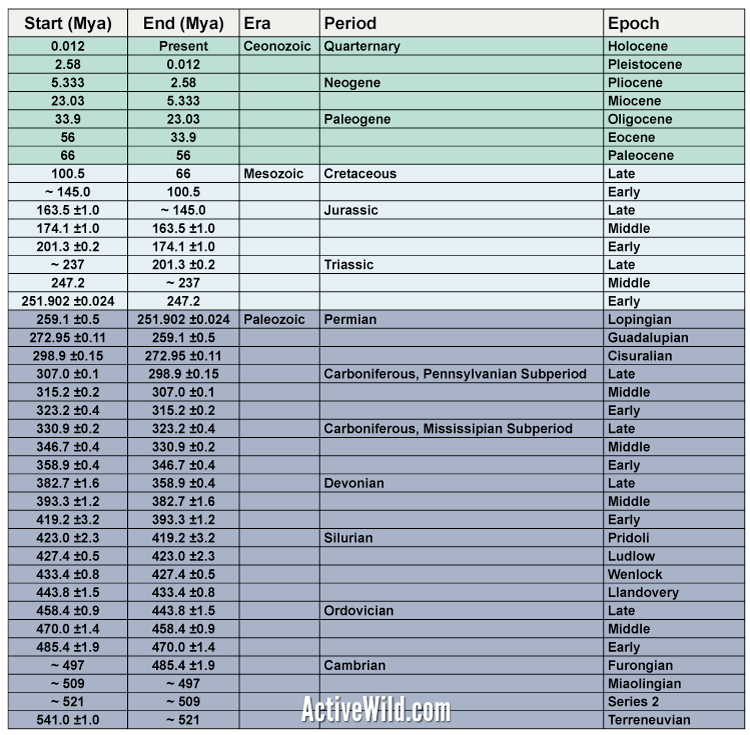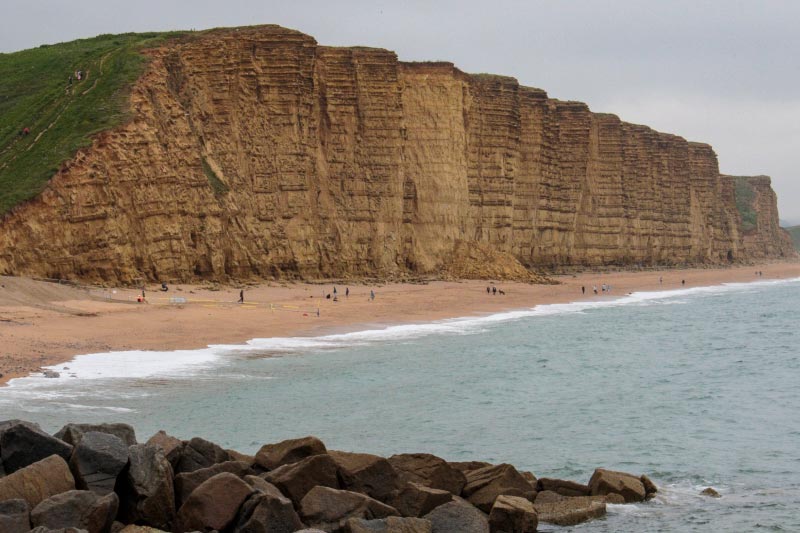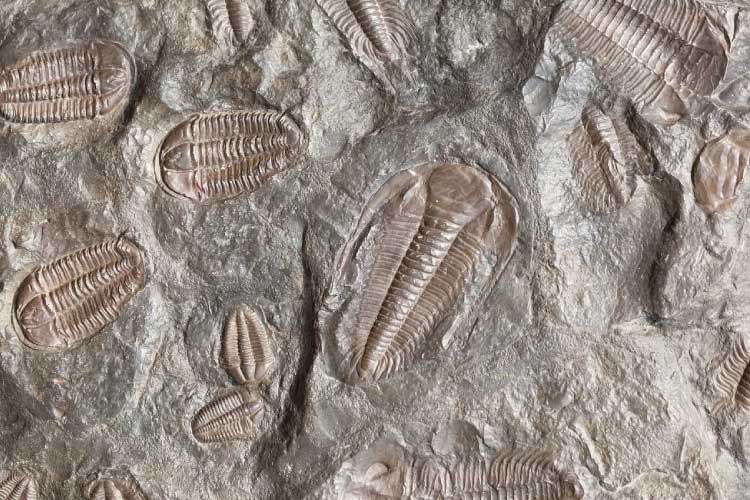Scientists often use terms such as “Mesozoic Era” and “Jurassic Period” when referring to certain times in Earth’s history.
Both the Mesozoic Era and the Jurassic Period are stages in the geologic time scale.
The geologic time scale links particular times in Earth’s history with the layers of rock in the Earth’s crust that were formed during those times.
For example, the Jurassic Period is the name given to the time in which a certain layer of rock in the Jura Mountains of Europe was being formed.
On this page you’ll find a complete explanation of the geologic time scale, including what it is, who uses it, and why it’s important…
What Is The Geologic Time Scale?
The geologic time scale is a means of measuring time based on layers of rock that formed during specific times in Earth’s history and the fossils present in each layer. The main units of the geologic time scale, from largest (longest) to smallest, are: eon, era, period, epoch and age. Each corresponds to the time in which a particular layer of rock was formed.
Rocks have been forming, layer upon layer, since the earliest days of Earth. These layers are like pages in a history book; by flipping back through them one can get an idea of what happened in the long distant past.
These layers of rock can be used as a reference system to compare the ages of fossils deposited within each layer. If a fossil is found in a particular layer – for example, rocks formed during the Jurassic Period, then it can be assumed that the species lived during the Jurassic Period.
The geologic time scale is a timeline and summary of important events in the geological, as well as the biological, history of the Earth.
An Example Of The Geologic Time Scale In Use
A well-known period of the geologic time scale is the Jurassic Period, made famous by the film Jurassic Park.
The Jurassic Period began around 201 million years ago (Mya), and ended around 145 Mya.
During this time, a particular layer of limestone was formed in the Jura Mountains of France and Switzerland. The Jurassic Period gets its name from these mountains.
From fossils found in rock formed in the Jurassic Period, palaeontologists can tell that dinosaurs became the dominant land animals during this time!
- You can find out more about the Jurassic Period on this page: Jurassic Period Facts
What Period Of The Geologic Time Scale Are We Currently Living In?
We are currently living in the Meghalayan Age of the Holocene Epoch of the Quaternary Period of the Cenozoic Era of the Phanerozoic Eon.
Geologic Time Scale Chart
Below is simple geologic time scale showing the eras, periods and epochs of the Phanerozoic Eon.
Geologic Time Scale Divisions
The main divisions of the geologic time scale, from largest to smallest, are:
- Eon
- Era
- Period
- Epoch
- Age
Unlike units of time such as seconds, hours and days, the units of the geologic time scale are not equal.
Earth’s entire history is divided into four eons; the Hadean, Archean, Proterozoic and Phanerozoic. The first three eons are referred to as Precambrian; the Phanerozoic is the eon in which we currently live.
- You can find out more about Precambrian Earth on this page: Precambrian Facts
The Cambrian Period – the first period of the Phanerozoic eon – is important, because during this time Earth underwent a profound change. In an event termed the “Cambrian Explosion”, a multitude of new life forms evolved in a relatively short space of time.
Eons represent such huge and diverse chunks of time in Earth’s history that they are divided into smaller time spans for convenience and accuracy. Eons are divided into eras, which are then further subdivided into periods, epochs and ages.
We are currently living in the Meghalayan Age of the Holocene Epoch, which is in the Quaternary Period in the Cenozoic Era of the Phanerozoic Eon
The beginnings and endings of the different geologic time categories are often determined by the emergence and disappearance of particular types of fossils in the layers of rock.
For example, at the start of the Cretaceous Period, fossils of the first flowering plants appear in the rocks, along with fossils of early bees and other insect pollinators.
In contrast, the end of the Cretaceous period is marked by the sudden disappearance of dinosaurs and many other species.
In fact, between the rocks of the Cretaceous Period and the Paleogene Period is a narrow layer of sediment that contains iridium – a metal found in asteroids. This is evidence that the extinction of the large terrestrial dinosaurs was caused by an asteroid strike.
- You can find out more about the Cretaceous-Paleogene Extinction Event on this page: What Killed The Dinosaurs?
Why Is The Geologic Time Scale Useful?
The geologic history of the Earth dates all the way back to the time that the Earth was formed, some 4.6 billion years ago.
Since it is difficult to work with such vast timespans, geologists and other scientists divided the Earth’s geologic history into smaller, more manageable units of time, together known as the geologic time scale.
This scale acts like a ‘calendar’ of the geologic events in Earth’s history, as recorded in the layers of rock in its crust.
The geology of Earth’s past has been studied by many scientists in different locations all over the world. Confusion arose because similar rock layers were given different names in different parts of the world.
The creation of the geologic time scale gave scientists a globally recognized standard for measuring and comparing the ages of rocks and fossils.
Because the geologic time scale is used worldwide, if a scientist from America says he found a fossil in a Cretaceous rock formation, then scientists in other countries will know (roughly) how old the fossil is.
How Was The Geologic Time Scale Invented?
The geologic time scale was not invented by any one person. Instead, it is the result of centuries of research and experimentation.
One of the first people to realise that rocks formed in layers was Nicolaus Steno, a Danish scientist and part-time fossil collector. In the 1660s, Steno published a paper in which he stated that layers of sedimentary rock are laid down horizontally in succession, and that the oldest layers will be found at the bottom, superimposed by the more recent layers. This was revolutionary thinking at the time.
In the late 1700s William Smith, a British engineer, surveyed the English countryside in order to determine the best places to build canals. He noticed that layers of rock in cuttings were usually arranged in predictable sequences and that the different strata were always found in the same positions relative to one other.
Smith also noticed that each stratum could be identified by the fossils it contained. Using this knowledge, Smith was able to compare rock layers in different regions; if they contained the same types of fossil, they were likely of the same age.
The work of pioneers such as Steno and Smith was important in the formation of today’s geologic time scale.
Today, the geologic time scale is managed by the International Commission on Stratigraphy (ICS), which is part of the International Union of Geological Sciences (IUGS).
How Are Fossils Important In The Geologic Time Scale?
Fossils are very important in the geologic time scale. Long before scientists had the technology to date ancient rocks, they used fossils to understand events that had happened in the Earth’s history and when they happened.
The fact that particular rock strata could be recognized by the fossils they contained allows geologists to match layers of rocks between different parts of a country, and even between countries and continents.
If rock strata contain the same types, or even species, of fossil organisms, then the rocks were likely formed at the same time.
For example, trilobites are first found in rocks dated to the Cambrian Period of the Paleozoic Era, no matter where in the world the fossil deposits are found.
This is very helpful in understanding how the continents split up and gradually moved into their current positions.
The small dinosaur Lystrosaurus has been found in fossil beds from the Late Permian Period in Antarctica, southern Africa and India. This indicates that, at this time in Earth’s history, these three continents were joined together. We know this because Lystrosaurs could certainly not have swum between these continents!
The Geologic Time Scale And Evolution
Investigation of the fossilized remains of organisms in rock layers gives scientists clues about how living creatures have evolved.
The oldest, lowest strata contain the fossils of simple, soft-bodied animals, while higher layers contain animals that are more complex and specialized. The fossil record, written in Earth’s rocks through the eons, shows how some species have evolved, and how others have become extinct.
How Do We Know The Ages Of The Ancient Rocks?
Although following the patterns of fossil distribution in rock layers enabled early geologists to state that one stratum was older than another, there was no way for them to know the exact ages of the rocks.
Today, radiometric dating is used to assign actual ages to the rocks of the Earth’s crust. The layers of igneous rock between the sedimentary, fossil-bearing layers can be dated using this technique. It involves measuring the rate of decay of radioactive elements, such as uranium and potassium, which were present when the igneous rock first solidified.
Who Uses The Geologic Time Scale?
Knowledge of the geologic timescale is vital for miners who are searching for particular types or ages of rocks to mine for important minerals.
Farmers may wish to know the age and origin of the sediments on their lands so that they can plant suitable crops and find water sources.
Geologists use the geologic time scale to determine the ages of surface rocks all over the world. This helps them to understand the history of the earth and the geologic changes that may have occurred to fold, fault or otherwise disrupt the layers of rock.
Paleontologists and other biologists use the geologic time scale to improve their understanding of when species first appear, how species interact with others living at the time, and when species become extinct.
Using the geologic timescale, paleontologists can piece together how living things have gradually evolved from simple organisms into large, complex, specialized species..
Paleontologist Professor Neil Shubin used the geologic time scale to calculate that, in order to discover a fossil of a new type of fish that was in the process of adapting to life on land, he would have to search in rocks that were 375 million years old. He used a geologic map to identify a site on an Arctic island where rocks of this age were exposed on the surface. He found this fossil fish in 2004, and named it Tiktaalik.
Further Reading
You can find out more about prehistoric life on the following pages:
- Precambrian Facts & Information: The Birth Of A Planet And The First Life On Earth
- Triassic Animals – Discover The Animals That Lived With The Dinosaurs In The Triassic Period
- Jurassic Animals – A List Of Animals That Lived In The Jurassic Period (That Weren’t Dinosaurs!)
- Cretaceous Period Animals That Weren’t Dinosaurs
- Dinosaur Facts, Pictures & Information. Discover The Rulers Of The Mesozoic Era!
- Dinosaur Periods: Discover the Triassic, Jurassic & Cretaceous Periods of the Mesozoic Era
- The Triassic Period Facts For Kids & Adults: The Ultimate Guide to the First Period of the Mesozoic Era.
- The Jurassic Period Facts: The Ultimate Guide To The Second Period Of The Mesozoic Era
- The Cretaceous Period Facts: The Ultimate Guide To The Third & Final Period Of The Mesozoic Era






